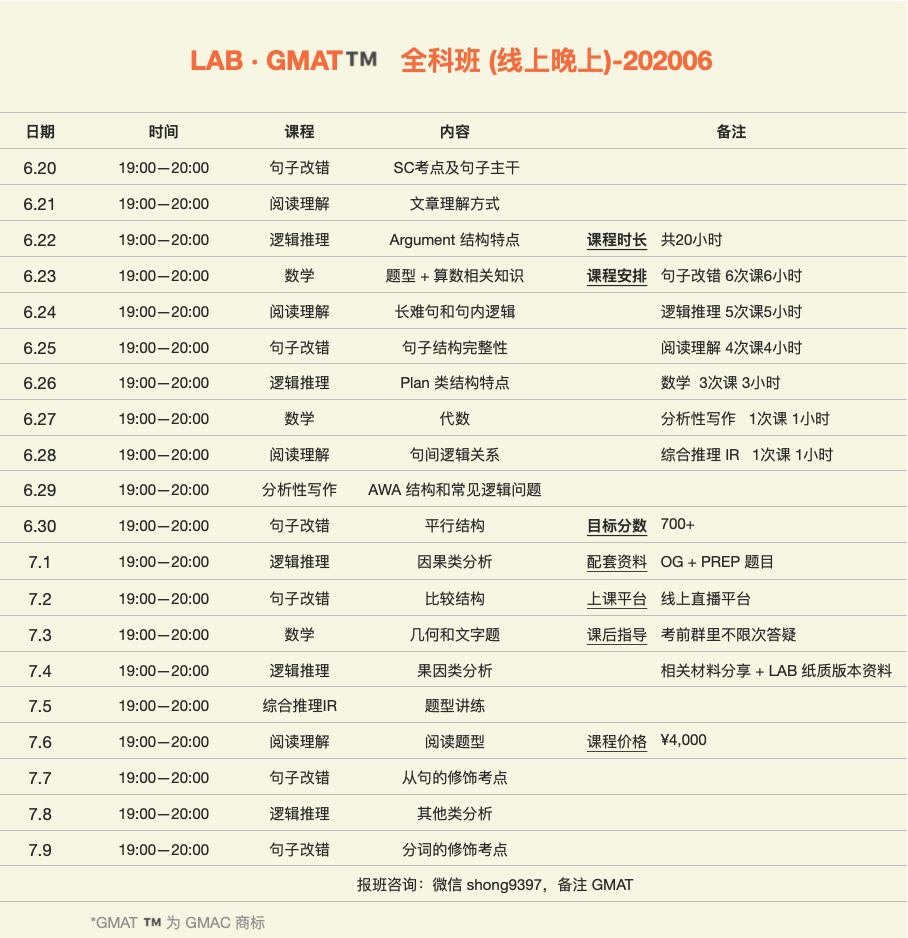GRE和GMAT文章阅读过程中存在着两个相关的麻烦:
第一是作者明确说了自己的看法,感觉自己读懂了,但可能因为时间紧张看错词或者没读懂句子结构,误会了作者意思导致错题。那怎样才能确保自己没有误会作者,也就是靠什么来检验自己的理解?
第二种是会明显发现自己对作者的一个表达可以有两种不同但是都合语法的理解,要如何判断哪个才是作者要表达的真实意思?
解决这两个问题,共同的解决方案就是看语境,具体说就是因为论点和论据具有一致性,所以论点和论据之间可以互为印证来判断作者真实意思,检验自己对作者意思的理解。
分别举一个GRE和GMAT真题的例子。
《GRE阅读一本全》第135篇。
George Milner cites three primary problems with the labeling of Cahokia, the large archaeological site by the Mississippi River, as a state rather than a chiefdom. First, finds at Cahokia are essentially similar to find at other Mississippian chiefdoms, except that the amount of earth moved in building the mounds at Cahokia was greater than elsewhere. Second, fewer people lived at Cahokia than is commonly estimated (Milner estimates that there were only a few thousand inhabitants); therefore, extensive taxes, trade, and tribute were not necessary to support them. Finally, while there is evidence of extensive earth movement, craftwork, trade, and elites at Cahokia, this does not indicate that Cahokia was politically centralized, economically specialized, or aggressively expansionistic.
读完文章以后可以想一个问题,George Milner觉得Cahokia是个很厉害的state国家还是不怎么棒的chiefdom酋邦?就我上课接触到的而言,大部分同学都会说George Milner觉得这是一个国家,因为A rather than B这个结构强调是前者,而不是后者。但如果按这么理解的话,后面会越读越尴尬。因为第一句说的three primary problems总起全文,后面几句话都是顺承展开,论点和论据之间应该是具有一致性的,那后面的三个论据也应该是说为什么是一个state,但第一个论据就说在Cahokia的发现本质上是近似于chiefdom,跟前面的state论点有矛盾。因为后面有except,有同学觉得可能这第一个表面上的矛盾只是作者在搞深刻,不算真矛盾,读到second的时候会发现更尴尬,因为说的是住的人很少,人少的话那至少在state和chiefdom之间更可能是接近于chiefdom。最后一个论据又在说尽管还凑合,但不意味着Cahokia就很厉害,也就是说不意味着是个state。所以会发现三个论据全部在打脸我们起初理解到的state观点。所以这时候可以重读论点,George Milner cites three primary problems with the labeling of Cahokia, the large archaeological site by the Mississippi River, as a state rather than a chiefdom.这句话可以先把中间插入语去掉,然后把labeling of Cahokia as a state rather than a cheifdom联系起来读,就是Cahokia被一些人认为是一个国家而不是酋邦,但是Milner说这对Cahokia的这种看法存在着3个问题,也就意味着他不认为这是一个state,也就意味着他觉得这应该是个chiefdom。后面就论证为什么应该是。总结一下就是,因为首先论据比较具体很容易想象,一般不会出偏差,其次论据比较多,要几个论据同时理解错,概率就很小了,所以如果论据和论点出现了矛盾,绝大部分时候都是论点的用词或者结构理解错了,需要重读。
再举个GMAT Advanced Questions超难真题集里面的例子。
这文章前两段在说书评编辑在考虑要不要请人给一本书写评论的时候要考虑书的可能销量。这一段说也不只考虑这一点,还要对文学史负责。If these were the only factors influencing editors, few books that stand little chance of selling well would ever be reviewed. But editors feel some concern about what might endure, and therefore listen to literary experts. A generation ago, a newspaper used a brilliant system of choosing which books to feature. The book review editor sent out a greater number of books than reviews he actually intended to publish. If a review was unenthusiastic, he reasoned that the book was not important enough to be discussed immediately, and if good reviews of enough other books came in, the unenthusiastic review might never be printed. The unenthusiastic reviewers were paid promptly anyway, but they learned that if they wanted their material to be printed, it was advisable to be kind.
根据这段话出了一个假词汇题。Which of the following words, if substituted for “brilliant” in line 26, would LEAST change the meaning of the sentence?
A. showy
B. articulate
C. literate
D. stingy
E. absurd
这个题绝大部分同学都会根据brilliant本身的感情色彩选articulate或者literate这两个好点的词,但都错的,答案是E。事实上brilliant本身没有absurd的意思,所以这里甚至不涉及到任何词义的理解,而纯粹考语境,这也是为什么前面说这是一个假词汇题。为什么这里可以用absurd来替代,可以看下语境。brilliant前一句说要听专业人士看法,确定知道什么书能永流传。所以以前会用一个brilliant的体系来决定要给哪本书找人写评论。后面就是在具体介绍这个体系,如果其中一个评论不喜欢这本书,那编辑就觉得这本书本身无价值;如果有对其他书的好评,就更不会关注被差评的书。但是,关键来了,作者最后说如果评论者也不只是为了恰饭,还想出版自己的评论,所以识相的话就最好都说好话。所以这种智障的操作手法和起初美好的意图适得其反,作者给的具体论据不是在说这个体系真的brilliant,而是absurd。总结一下就是,有时候论点的用词本身意思比较熟悉,但还要根据论据解释来检验作者在语境里用的意思。
上面两个例子都是通过论据反推论点的意思。但其实对我们提升阅读速度和准度更有意义的是通过论点来顺推论据的意思。从提升阅读速度来说,就是一般读到观点了以后,不管是作者还是其他学者的观点都需要刻意记一下,带着观点的意思往下读,论据读得懂最好,论据没读懂就靠观点来框定大概意思接着往后读,不要纠结论据。从提升阅读准度来说,因为大家有不同的世界观,对同一个字面意思可能有不同的理解,比如剩半杯奶茶这件事情,乐观的作者觉得真棒还剩半杯,悲观的作者觉得天哪怎么只剩半杯了,所以一个论据到底是什么意思,还是要紧扣观点来判断。
举两个例子说明一下。Despite winning several prestigious literary awards of the day, when it first appeared, Alice Walker’s The Color Purple generated critical unease over puzzling aspects of its compositions. In what, as one reviewer put it, was “clearly intended to be a realistic novel,” many reviewers perceived violations of the conventions of the realistic novel form, pointing out variously that late in the book, the narrator protagonist Celie and her friends are propelled toward a happy ending with more velocity than credibility, that the letters from Nettie to her sister Celie intrude into the middle of the main action with little motivation or warrant, and that the device of Celie’s letters to God is especially unrealistic inasmuch as it forgoes the concretizing details that traditionally have given the epistolary novel (that is, a novel composed of letters) its peculiar verisimilitude: the ruses to enable mailing letters, the cache, and especially the letters received in return.
这是一篇文章的第一段,一共两句话,但第二句很长,后面的细节很麻烦,大部分人读过去都是懵的,这时候不应该纠结细节,而是要跳出来看句子结构,用主干或者论点来框定后面的意思,后面的pointing out that…, that, and that是平行结构作为一些解释性的论据在说明前面主干的内容,最终都是在呼应violations那个词,也就意味着后面三个细节都是在具体阐述怎么违反现实主义。知道这个关系以后,具体的三个细节到底是什么意思反而没那么重要,而事实上后面那个对应题目考察的也是这层关系。同一篇文章的第二段也是一样复杂,只是这时候是难在句间关系。要想读好的话就是开头的观点句一定要刻意记住,进入论据部分了,读不懂的话想一下作者想通过这个论据呼应的观点也就可以继续放心地读下去,因为至少在第一遍通读文章的时候,既然作者想表达的本质意思都已经清楚了,具体的细节理解有一些瑕疵也问题不大。
再比如下面这篇文章。An influential early view held that ecosystems contain niches for a limited number of species and that competition for resources among species—whether native or nonnative invading ones—determines ecosystems’ species composition. However, factors other than competition often help explain invading species’ success. For example, the American grey squirrel, often cited as a classic example of competitively superior invading species, was introduced in England in 1876 and now thrives, while the native red squirrel population has declined. Although scientists have found gray squirrels to be more efficient foragers than red ones, they also note that even before the gray squirrel’s arrival, Britain’s red squirrel populations had a periodic tendency to die out, only to be subsequently reintroduced. Furthermore, many gray squirrels are silent carriers of a disease fatal to red squirrels.
对于最后一句话的逻辑有的同学会有疑问,觉得既然倒数第二句说的是跟灰色松鼠无关,最后一句说的跟灰色松鼠有关,意思明明是相反的,为什么要用furthermore这个表示顺承的逻辑词?是不是作者写错了。对于GRE和GMAT考生来说,做阅读的时候怀疑作者用词错误胆子也太大了,千错万错都是我们自己读错,没理解到作者的深意。那作者在这里的深意要怎么理解?当然是要看对应观点来理解。分析结构可以发现第二句是作者观点,第四句和第五句分别作为论据在支撑第二句。第二句的重点是“factors other than competition”,就是在强调跟竞争无关。所以理解论据的时候要注意论点的笼罩影响,第一个论据是说:在灰色来之前,红色就死了,所以跟灰色没有关心,所以!跟竞争没有关系;第二个论据是说:就算跟灰色有关系,那也跟竞争没有关系,因为可能是病毒致死,不是竞争(抢吃的)致死。就相当于进一步撇清了跟竞争的关系。这样我们才算理解到作者想表达的真实意思。
总的来说就是读文章的时候刻意记论点,预判论据意思,提升理解速度;但如果论据和论点有冲突,重读论点,提升理解准度。
另外,
GRE阅读目前已经上线了147篇考前必做题,视频解析正在加速录制。其中Passage 1和Passage 2开放了权限。
GMAT阅读的100篇精讲中已经录制完成了官方难题部分,对应Passage 12到Passage 20,也已经开放权限。需要了解这部分内容的同学可以进入LAB相应模考网站做相应题目,文章和题目的讲解视频放在了每篇文章第一题。
LAB 模考平台入口:
labhaohao.cn
更多文章理解思路会在GRE和GMAT班级上讲到,对班级感兴趣的同学微信咨询~




本文源自微信公众号:LABcircle
